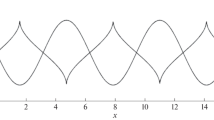Abstract
An iterative method of solving quasilinear hyperbolic equations of the type
in the domain (0, 1)×(0,T) is proposed. For each given initial-boundary-value problem of this type with boundary conditions of the first kind (second kind), a conjugate problem of the same type that has boundary conditions of the second kind (first kind) is defined. From the relations connecting the solutions of a pair of conjugate problems, a series of wave equations is created. The method proposed consists in calculating the solutions of the wave equations of this series. Theoretical proof of the convergence of the solutions of the wave equations to the solutions of the conjugate quasilinear problems is left as an open question. However, numerical results are presented to demonstrate that, under favorable circumstances, the solutions of the wave equations do converge to the solutions of the conjugate quasilinear problems.
Zusammenfassung
Ein iteratives Verfahren zur Lösung quasilinearer hyperbolischer Gleichungen des Typs
im Gebiet (0, 1)×(0,T) wird entworfen. Für jedes gegebene Anfangs-Randwert-Problem dieses Typs, dessen Randbedingungen der ersten (zweiten) Art sind, wird ein konjugiertes Problem desselben Typs definiert, dessen Randbedingungen der zweiten (ersten) Art sind. Aus den Beziehungen, durch die die Lösungen eines Paares konjugiererter Probleme verbunden sind, wird eine Folge von Wellengleichungen gebildet. Das entworfene Verfahren besteht in der Berechnung der Lösungen der Wellengleichungen dieser Folge. Der theoretische Beweis der Konvergenz der Lösungen der Wellengleichungen gegen die Lösungen der konjugierten quasilinearen Probleme wird als offene Frage gelassen. Doch werden numerische Resultate angegeben, die zeigen, daß die Lösungen der Wellengleichungen unter günstigen Umständen tatsächlich gegen die Lösungen der konjugierten quasilinearen Probleme konvergieren.
Similar content being viewed by others
References
Abrašin, V. N., Žadaeva, N. G.: Difference schemes for a nonlinear hyperbolic equation with nonlinear boundary conditions. Dokl. Akad. Nauk BSSR19, 293–296 (1975). (In Russian.)
Chung, T. J.: Convergence and stability of nonlinear finite element equations. AIAA J.13, 963–966 (1975).
Gavurin, M. K., Belyh, V. M., Šidlovskaja, N. A.: The numerical solution of quasilinear equations of parabolic and hyperbolic types. Metody Vyčisl.9, 22–27 (1974). (In Russian.)
Lavery, J. E.: Solution of inhomogeneous quasilinear Dirichlet and Neumann problems by reduction to the Poisson equation and a posteriori error bounds. J. für reine angew. Math.299/300, 73–79 (1978).
Author information
Authors and Affiliations
Rights and permissions
About this article
Cite this article
Lavery, J.E. Numerical solution of a class of quasilinear hyperbolic equations by reduction to the wave equation. Computing 25, 77–88 (1980). https://doi.org/10.1007/BF02243883
Received:
Revised:
Issue Date:
DOI: https://doi.org/10.1007/BF02243883



